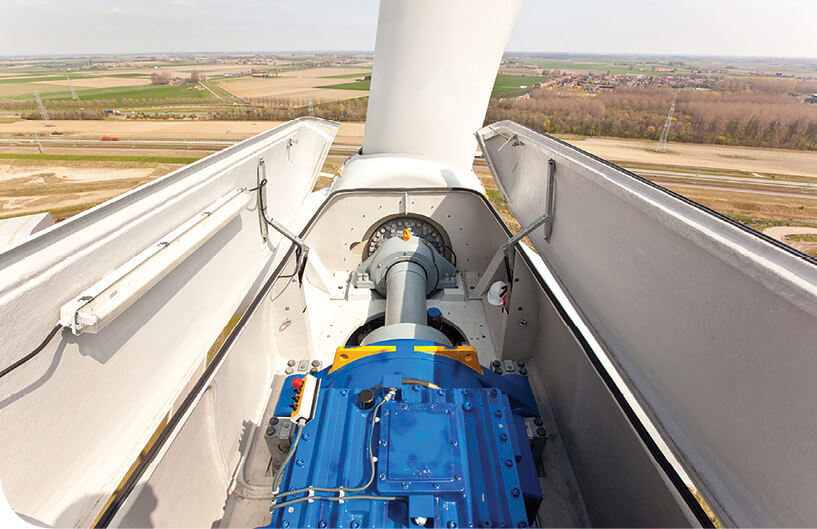Luis Rojas / Americas Industrial Marketing Advisor – Energy / ExxonMobil
Often located in remote environments, wind turbines are exposed to some of the harshest conditions in the industrial world, including extreme temperatures and significant water exposure.
In these conditions, proper equipment lubrication is critical. It can help protect system components, minimize unscheduled downtime, reduce costs, extend oil drain intervals, and enhance safety through reduced human-machine interaction.
Getting the most out of your equipment requires the use of high quality synthetic lubricants, and when it comes to lubricant selection, there is a wealth of information available regarding factors that should be considered.

A typical wind- turbine lubricant has an oil drain interval of 36 months. However, more advanced synthetic lubricants formulated specifically for wind can help extend those intervals.
However, one of the most under appreciated factors is a balanced formulation. Equipment performance depends on using lubricants developed with a balanced formulation approach, which means using optimal base stocks and a tailored additive package that meets the specific needs of the wind industry.
For example, a typical wind turbine lubricant will have an oil drain interval of 36 months, but more advanced synthetic lubricants formulated specifically for wind can help extend those intervals even further. In fact, one Mobil synthetic lubricant formulated specifically for wind turbine gearbox and bearings has been shown to extend oil drain intervals in turbine applications up to five years.
In addition, advanced synthetic lubricants are formulated with base stocks and additives that offer:
- High performance in extreme temperatures
- Enhanced oxidation and water resistance
- Protection against wear and micropitting
- Long equipment life, and
- Energy efficiency benefits
To better understand how formulation impacts wind turbine performance, let’s look at a few specific examples.
Micropitting
Micropitting is a common challenge for wind turbine operators. It can form on surface-hardened gears within the first several hours of operation if the gear box is not properly lubricated. The result is reduced reducing gear tooth accuracy.
To mitigate this effect, operators should select an oil formulated with a micropitting additive package, such as conventional extreme pressure additives, as well as employ a gear finish as specified by American Gear Manufacturers Association’s AGMA 6006 standard.
Further, an oil formulated with advanced base fluids that provide a high viscosity index – generally 160 or higher – and lower traction coefficient, can also help. The higher viscosity index can provide a thicker lubricant film at operating temperature, and the lower traction coefficient can help increase energy efficiency.
Water contamination
Water contamination can have a significant impact on wind turbine performance, particularly in offshore environments where water exposure is far greater.
When water is present in oil, it can cause additive depletion, stable emulsions, and higher viscosity. It can also lead to equipment issues, such as filter blockage and accelerated wear of system components.
Lubricants formulated with specific additives can help mitigate the effects of these contaminants by improving the oil’s resistance to water contamination, and also improving its wet oil filterability.
Foam and entrained air
Foaming is another notable equipment challenge for wind turbine operators. For example, when foam bubbles up and breaks through a shaft seal, it makes a mess inside the nacelle, creating a “slip” safety hazard. Further, as foam forms on the surface of the oil, it may interfere with the oil level float switch, giving a false reading and causing a potential alarm. Finally, if foam enters the oil circuit, a momentary loss of oil pressure or flow could occur, also giving rise to an alarm. All instances could result in unnecessary down time.
High quality lubricants can be formulated with specific base stocks and additives that are engineered to resist foaming, helping reduce related concerns.
Ensuring a balanced formulation
The factors outlined above are just a few examples that show how the balanced formulation of wind turbine lubricants can help improve equipment performance, and as a result, help reduce costs and minimize unexpected equipment downtime.
Consider, for example, Mobil SHC Gear 320 WT, which is a new advanced gearbox oil. Formulated to deliver maximum oil life – including drain intervals that are two times longer than competing oils – this lubricant is designed to specifically provide protection against conventional wear modes, such as scuffing, and high level of resistance against micropitting fatigue.
In short, the oil’s balanced formulation results in benefits that can help enhance equipment protection and extend oil drain intervals. It’s clear that when it comes to selecting a wind turbine lubricant, formulation matters.
So, to help optimize the productivity and profitability of your operation, be sure to work with your lubricant supplier to identify equipment-related pain points and identify the lubricant that is best formulated to suit your needs.
Filed Under: Lubricants, News, O&M





